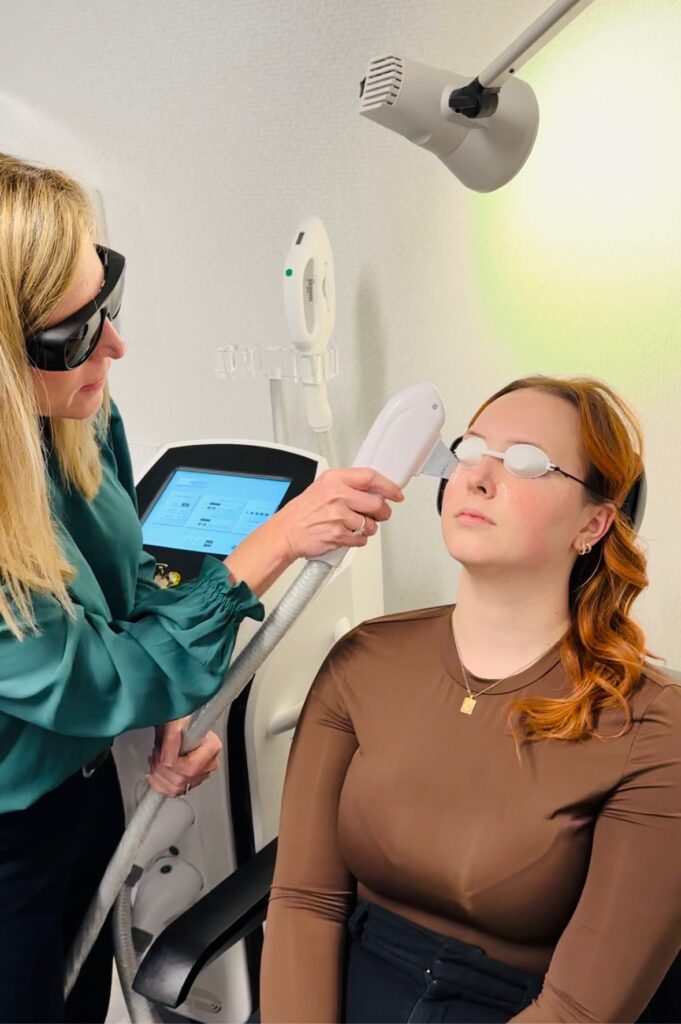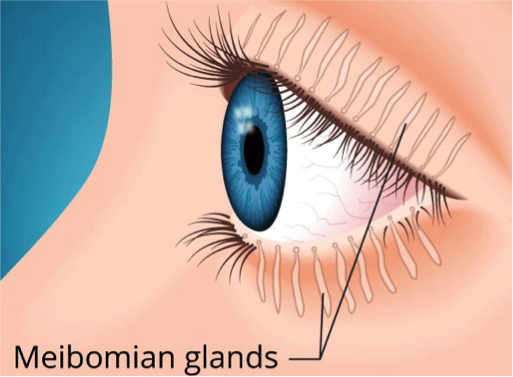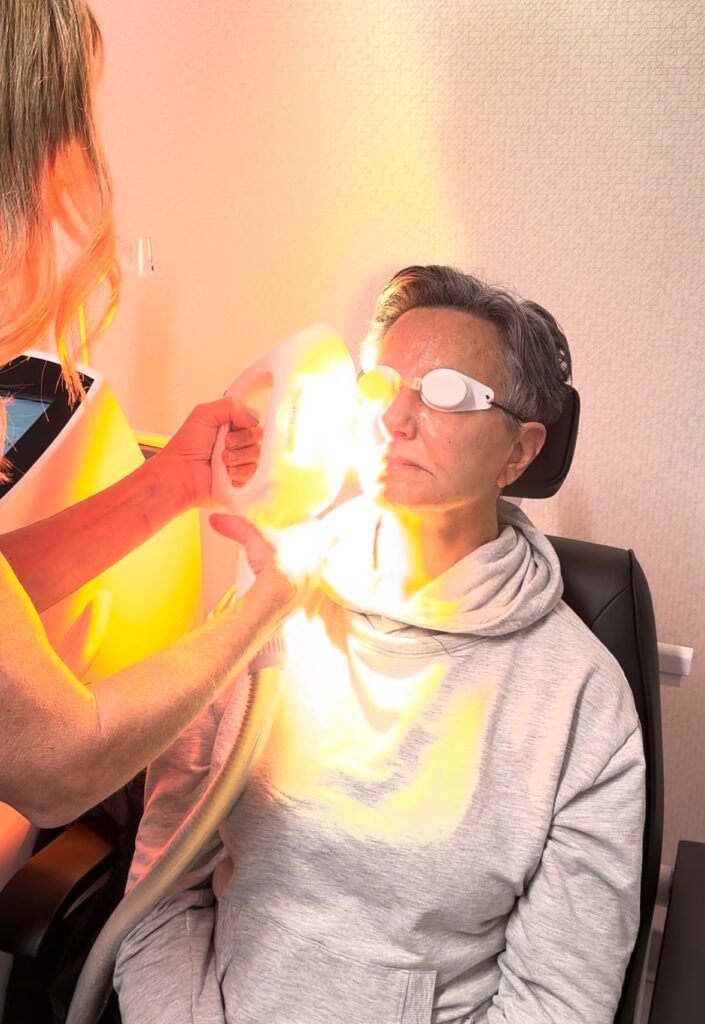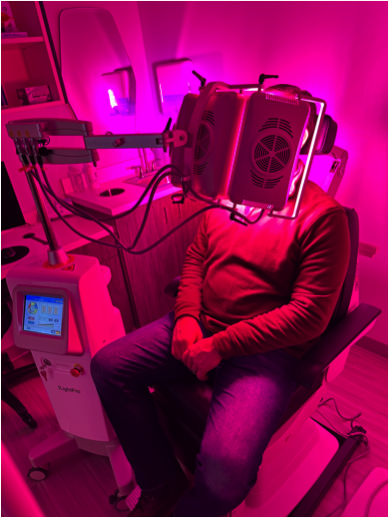YOU DON’T HAVE TO LIVE WITH DRY EYE

What is intense pulsed light (IPL) treatment for dry eyes?
IPL treatment uses pulses of light to treat a common cause of dry eye — meibomian gland dysfunction. It liquefies hardened oil that can plug the gland, clearing it and stabilizing the tear film. It also kills bacteria and mites and decreases inflammation by closing abnormal blood vessels. IPL has been used by dermatologists to treat facial rosacea for decades. They found people with dry eyes were reporting improvements, so they started using IPL to treat dry eye specifically.
The combination of inflammation, plugged meibomian glands and bacteria or mites can cause an unstable tear film. In turn, this can lead to:
- Irritation
- Itching
- Blurry Vision
- Swollen eyelids
We can evacuate the clogged glands, but if we don’t reduce the inflammation that got you here, your benefits may not last long. We need to control the inflammation to thin out the oil and keep it moving. This will help protect the glands from future loss and improve your comfort and the ocular surface. Think of it as your eyes being the branches of a tree and IPL treats the tree trunk improving tear flow to your eyes through the branches.
How does IPL treatment for dry eyes work?
An eye doctor uses a device that pulses light in the 500 nm to 1,000 nm wavelength over the skin around the eyes. This is a broad band of light, so it is not as harsh on the skin as a laser, which is a narrow and focused beam of light.

IPL treatment addresses the issues commonly seen in dry eyes due to meibomian gland dysfunction. It does this by working on several different aspects of the condition:
- Warms up the hardened oil plugging the meibomian gland (the gland that produces the oily layer of the tear film), preventing the tear film from evaporating
- Decreases inflammation by closing abnormal blood vessels
- Eliminates eyelash mites (Demodex) and bacteria that infect the eyelid and meibomian glands
- Promotes collagen synthesis at the cellular level
- Adjusts the concentration of tears to more normal levels
IPL therapy has been shown to be effective for treating blepharitis as well.
What is the procedure for IPL treatment and how do I prepare?
IPL treatment is a 10 minute in-office procedure. It does not hurt. IPL treatment involves the following general steps:
- Protective, opaque goggles that serve as eye shields are placed on the eyes.
- A gel (that is commonly used for ultrasound) is spread around the eyes, eyelids and cheeks. This makes the treatment more effective and protects the skin by spreading out the light energy.
- Flashes of low-level light are pulsed in the area beneath the eyes, the area next to the eyes (toward the ears) and on the cheeks.
- This procedure is repeated on the other side of the face.
- The goggles and gel are removed.
- The meibomian glands may be expressed to unclog the openings of the glands.

What is the aftercare for IPL treatment?
After the treatment session, a sun-protection cream may be applied around the eyes. For the first two days after the treatment, exposure to the sun should be avoided. This can be done by staying out of the sun as well as by applying sunblock and using a hat when outdoors.
How many IPL treatments are needed?
In general, it takes approximately 4 separate IPL sessions every 2 weeks to effectively treat dry eye syndrome caused by meibomian gland dysfunction. Maintenance treatments may also be scheduled 6-12 months later, if needed.
How effective is IPL treatment for dry eye?
In a 2015 study found that doctors saw an improvement in tear break up time, the time it takes for dry spots to appear in the tear film after a full blink. Over 90% of patients who underwent IPL treatment reported that they were satisfied with the results.
Treating the cause of Dry Eye, Blepharitis and Meibomian Gland Dysfunction with LLLT
Dry eye is a common inflammatory condition that affects millions of people every year. It is caused by the tear glands failing to produce enough tears, or when tears evaporate too quickly from the eye’s surface, making the eye’s tear film unstable. The condition causes classic symptoms of dry eye, including a feeling of grittiness or burning in the eye, sensitivity to light, blurred vision, stinging, and redness. In addition, dry eye symptoms include excess tears and watery eyes.
Blepharitis is another common eye condition, but unlike dry eye, it typically affects the eyelids, specifically where the eyelashes grow. It is generally caused by the clogging of oil glands located near the base of the eyelashes, causing a build-up of bacteria, as well as redness, itching, burning, and a crusty or greasy appearance around the eyelids. Blepharitis also shares symptoms with dry eye, like watery eyes, blurry vision, and sensitivity to light.
In fact, blepharitis and dry eye have something else in common. Both conditions are often caused by something called Meibomian Gland Dysfunction (MGD). MGD is the result of a blockage in the meibomian glands, tiny oil-producing glands found along the eyelid, from the outer to inner corners. This blockage prevents the glands from producing enough oil to keep adequate tears in place, leading to increased tear evaporation and dry eye. These blockages can also cause an overgrowth of bacteria on the eyelids, leading to blepharitis and demodex infestation.

How Does Low-Level Light Treatment Work?
Low-level light treatment (LLLT) is a non-invasive therapy that uses specialized LEDs to increase tear production by reducing inflammation and stimulate cell activity. It helps rejuvenate oil gland activity in the eyelids. The red and blue light target different exacerbated symptoms, resetting and refreshing your eyes. The red light stimulates eyelid glands and blood flow, reducing inflammation, which helps unclog the meibomian glands and alleviate the symptoms of dry eye syndrome, MGD and blepharitis. The blue light is antimicrobial and attacks the Demodex or other bacteria that can build up on the eyelids. It will require multiple procedures and the effects are cumulative. A typical LLLT session lasts 20 minutes and is a completely painless experience. We recommend 2 treatments twice a week for 3 weeks. Improvement will continue months after treatment.
What Are the Benefits of Low-Level Light Treatment?
Aside from the fact that it is painless and does not require any downtime, LLT is also very safe, effective, and has few side effects. These factors make it a great choice for those who suffer from dry eye and blepharitis. The possible benefits of LLLT are numerous, including:
- Improved production of tears
- Reduced inflammation and irritation
- Improved and healthy tear film
- Increased blood flow to the eyes
- Reduced pain and discomfort
- Clearing of blocked oil glands
- Reduced symptoms of dry eye and blepharitis
Tired of treating the symptoms and not the cause of your dry eye? Let us diagnose the root of your dry eye and deliver the results you deserve!
